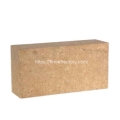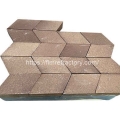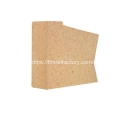- Performance. Innovation. Worldwide. Your trustworthy Refractories Manufacturing Partner--Fireramo
- +86 175 3769 7777
Ceramic Fiber Module
- Category: Ceramic Fiber
- |
- Author: Fireramo
Ceramic Fiber Module is a new type of refractory material made of a mixture of ceramic fiber and glass fiber. Ceramic fiber modules are mainly used to simplify and speed up kiln construction and improve the integrity of the furnace lining.
- Main Composition: Al2O3+SiO2≥96%
- Application: Industrial Furnaces Insulation Layer
- Raw Material: Bulk Fibers
- Color: White
- Bulk Density: 160Kg/m3~240Kg/m3
- Capacity: 3000 MT per month
- Package: Export Wooden Pallets and Carton Case
Search
Contact
High quality refractory bricks
Product Details
Ceramic Fiber Modules for Sale
Description of Fireramo Ceramic Fiber Module
Ceramic Fiber Module is a new type of refractory furnace lining products, mainly used to simplify and speed up the construction of kiln, improve the integrity of the lining. It is white in color and neat in size, and can be directly fixed on the steel plate anchor nails of industrial kiln shell. Ceramic fiber module has good refractory heat insulation effect, improve the integrity of the kiln refractory heat insulation, promote the progress of the kiln masonry technology.
What is ceramic fiber module?
Ceramic fiber module is a new type of composite material, which is made of a mixture of ceramic fiber and glass fiber. Ceramic fiber module has the advantages of good high temperature resistance, corrosion resistance, low thermal conductivity, high compressive strength, etc. It is a very effective high temperature insulation material.



Features of Fireramo ceramic fiber modules
Excellent chemical stability
Ceramic fiber modules are stable to most chemicals and do not react with other acids, alkalis and salts except strong alkali, hydrofluoric acid and phosphoric acid.
Excellent thermal stability
Ceramic fiber module does not melt, soften or decompose at high temperature, and maintains stable physicochemical properties for a long time.
Excellent elasticity
Ceramic fiber module has a large modulus of elasticity, can resist the role of mechanical external forces.
Excellent thermal insulation performance
Ceramic fiber module has a low thermal conductivity, which can effectively prevent the transfer of heat and improve the thermal efficiency of the furnace.
Excellent thermal shock resistance
Ceramic fiber modules can withstand drastic changes in temperature without damage.
Excellent construction performance
Ceramic fiber modules can be cut arbitrarily and do not require maintenance and drying, making construction easy and fast.
Low thermal conductivity
Ceramic fiber modules with low thermal conductivity and small heat capacity can improve the thermal sensitivity of the furnace, reduce heat loss and improve product quality.
Simple maintenance
Ceramic fiber modules have a simple structure and are easy to construct. They do not require oven baking and are easy to maintain and overhaul.
Applications of Fireramo Ceramic Fiber Modules
Ceramic fiber module is widely used in industrial kilns, heating devices, high-temperature pipelines and high-temperature containers for thermal insulation due to its excellent performance. It is used as an energy efficient refractory furnace lining material, which can effectively reduce the surface temperature of the furnace lining and improve the thermal efficiency of the furnace, thus reducing energy consumption and improving product quality.
Ceramic Fiber Module Specifications
| Description | STD RCF MODULE | HP RCF MODULE | HZ RCF MODULE |
|---|---|---|---|
| Chemical composition(%) | |||
| Al2O3 | ≥43 | 44-47 | — |
| Al2O3+SiO2 | ≥96 | ≥98 | — |
| Al2O3+SiO2+ZrO2 | – | – | ≥99 |
| ZrO2 | — | — | ≥15 |
| Fe2O3 | <0.5 | ≤0.3 | ≤0.2 |
| Na2O+K2O | ≤0.5 | ≤0.2 | ≤0.2 |
| Classification Temperature(℃) | 1260 | 1260 | 1430 |
| Permanent Heating Linear Change(%) | 1000℃X24h≤-2.5 | 1100℃X24h≤-2.5 | 1350℃X24h≤-2.5 |
| Density(Kg/m3) | 160~240 | ||
| Thermal Conductivity(W/m.k) | |||
| 400℃ | 0.09 | 0.1 | 0.118 |
| 500℃ | 0.119 | 0.12 | 0.149 |
| 600℃ | 0.152 | 0.175 | 0.172 |
Specializing in refractory materials for over 20 years, we provide professional refractory solutions for the global high temperature industry.
Theme By Fireramo














